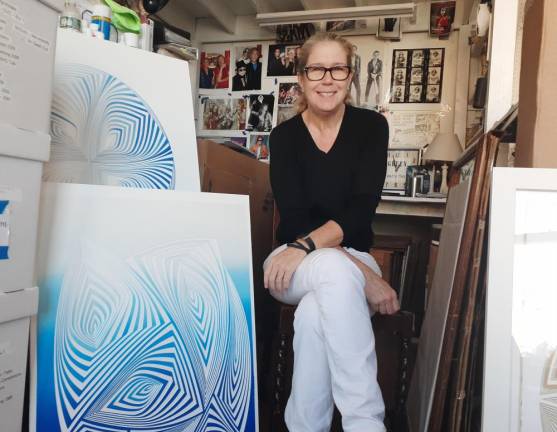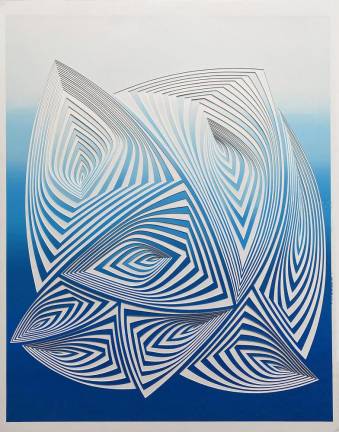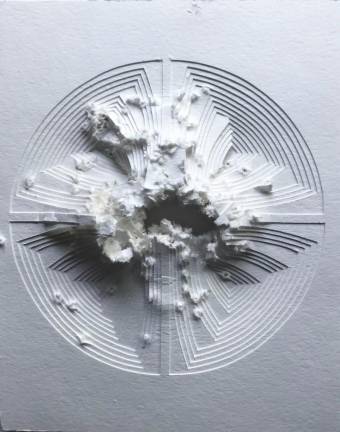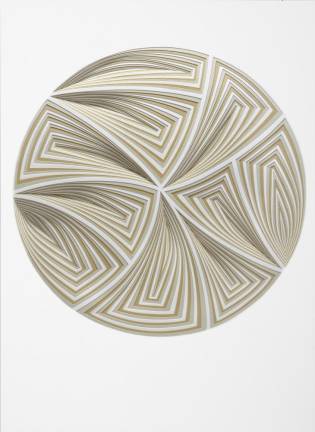When artist Elizabeth Gregory-Gruen starts work on one of her intricate hand-cut paper designs, she does not have an architect’s vision of what the finished image will be.
With the use of a surgeon’s scalpel, what she does have is a firm hand, deep focus and an artist’s trust that her labor-intensive process will produce yet another distinctive masterpiece.
“I don’t even know until halfway through if the piece is going to be anything that I want to keep or continue with,” Gregory-Gruen says of the often weeks-long process bent over her geometric cut works done mostly on two-ply museum board. “I’m always discovering with it, and it’s different every single time.”
Her artwork is unique – free hand-cut paper using no computers or guides. It all starts with one sheet of paper, followed by another placed under it, then another, sometimes just white-on-white, other times infused with silkscreen gradated colors.
“The idea is layers,” Gregory-Gruen explained of her cut work process. “I start with the top layer – I make no drawing – I just take the knife and I cut. Then I add an adhesive (special double-sided ones), and I add another layer of paper and cut again and continue that processed until finished.”
The result is mesmerizing. There is symmetry, abstraction, precision and wonder in each piece. The play of color and geometry in subtle and striking patterns invite curiosity, not clarity.
Fashion Designer
The idea for each emerging pattern “just comes” as she works, says the West Village resident and Parsons School of Design graduate who worked as a fashion designer for many years before returning to her paper artwork more than a decade ago. “You just have to clear your mind and pull the lines,” and be in tune with a sort of meditative aspect to the evolving process, she said. “In the end, it tells a story and brings the viewer into a conversation with the movement of light and color.”
Married to famous rock photographer Bob Gruen, Gregory-Gruen grew up in an artistic family where both her mother and grandmother were painters. She tried oil paint very early on but did not really connect with that medium, and in her teens started exploring “cutting up paper” which later evolved to now numerous exhibitions of her one-of-a-kind and sought-after designs.
Adding to the element of the unexpected in her creations, there is a gunshot version of her work. A real gunshot. Done up in the country, she positions a few of her work, usually the white-on-white designs, and uses a 12-gauge shotgun to literally shoot them from behind.
“It’s really about purity and shadow,” Gregory-Gruen says of the compelling new work she discovers when she turns the pieces around. It becomes another conversation as the work has now “been elevated to another level.”
Visceral Reaction
Not everyone knows it’s a gunshot that creates the unusual perforations in the displays tucked inside plexiglass cases at her exhibitions. When they do find out “some people get very, very upset. They don’t like to hear of people shooting their work,” she said. Other people laugh. “They’re like, ‘this is kind of strange.’ It’s so foreign they don’t know what to do with it.”
The general response to her body of work is usually immediate – a visceral reaction – she says. “I’ve never really had anybody think about it,” when deciding whether to acquire a certain piece of work on first viewing. “They say ‘I’m connected with this, it’s coming with me!’”
There is a form of comfort with her artwork, a rhythm and routine to the multi-layer flow of the images, but also relief as the patterns change continually under different lights and angles of viewing.
At first glance, it would be easy to assume that Gregory-Gruen’s disciplined, detailed work may have been computer-generated, so seamless and perfect the contours appear. She is familiar with this observation.
“If you look very closely, it’s not all perfect, and these imperfections are the perfections,” she said of her meticulously hand-sculpted images. “It’s something that can change, it’s something that can continue its path towards something positive – or allowing you to expose something positive – by thinking and contemplating on this.”
To learn more about Elizabeth Gregory-Gruen’s artwork and exhibitions, visit ivybrowngallery.org/artist/elizabeth-gregory-gruen/.



